A new ecommerce mobile app is one of the best ways to drive sales for your Shopify store. Mobile apps convert higher than the mobile web, so generating sales from your app won’t be a problem. But the app will only have success if customers actually download it.
That’s why ecommerce mobile app marketing needs to be a top priority for your Shopify store.
Whether your app is already complete, in development, or still in the pre-development planning stages, you need to start brainstorming marketing ideas for your Shopify app today.
Marketing a mobile app for ecommerce isn’t necessarily the same as promoting a traditional product or service. You need to take a unique approach to this process.
I’ve personally overseen the launch for dozens of ecommerce apps. It’s abundantly clear which ecommerce sites were prepared with marketing ideas for their Shopify app.
After learning from the success and the mistakes of others, I want to pass my knowledge to you. Use this guide to learn how to implement the best mobile app marketing tactics for ecommerce.
1. Build Hype Early
If you wait until launch day to promote your new ecommerce mobile app, it’s too late. You need to start promoting the app as early as possible, even if it’s with something as simple as a “coming soon” page.
Even if you haven’t started development yet, the sooner you can get exposure for your app, the more successful it will be.
If you review the top reasons why you need an ecommerce mobile app, you’ll quickly learn that mobile commerce is trending upward, and consumers prefer to shop from apps.
Promoting the app as early as possible builds anticipation in the minds of your customers. This is an age-old psychological marketing strategy. When the app finally launches, they’ll be ready to download it and start shopping immediately.
Just avoid publicizing a firm launch date until the app is actually complete. So if you’re starting to build your app in March, don’t start running promotions saying the app will be live in June.
Things happen during the development process that are sometimes out of your control. You don’t want to promise an app and not deliver, or worse, rush through development to meet a deadline that results in performance issues.
2. Leverage Your Website For App Promotion
It sounds simple, but it’s shocking how many websites don’t have a direct download link for their app. Even more surprising, some ecommerce businesses don’t have any mention of their app at all on the website.
You just went through all of the effort to build a mobile commerce app. Don’t let those efforts go to waste by failing to promote it on your biggest platform.
Shopify owners make the mistake of thinking that customers will go to great lengths to find their app. But that’s simply not the case. You need to make this process as easy as possible for them.
Here’s a great example from the H&M website.
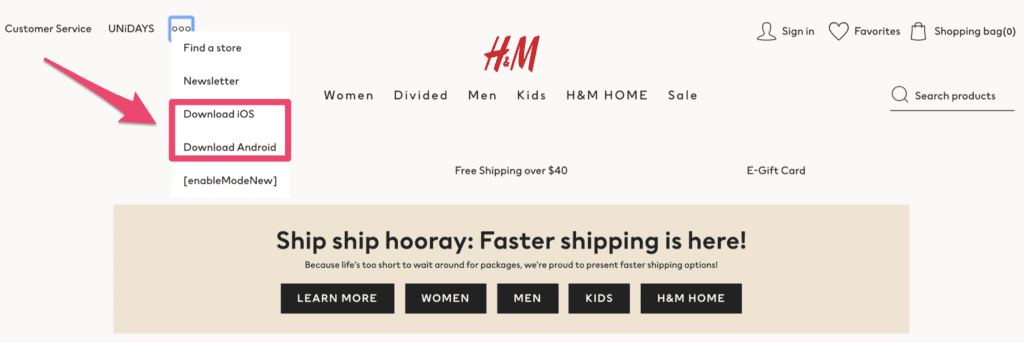
H&M has a global presence. It’s always a good idea to follow the lead of companies that succeeded before you.
The menu on this ecommerce site has a direct link to download the app for both iOS and Android.
Just saying “we have a mobile app” on your site isn’t enough. It forces customers to take extra steps to search for your Shopify app in the app store. Each additional step reduces your chances of getting a download.
But think about how much traffic your Shopify site gets each day, week, or month. Imagine if just 5% or 10% of that traffic downloaded the app. That’s how you get thousands of downloads at a time.
3. Showcase Your App in Confirmation Emails
You want to promote your app through distribution platforms that have the most exposure. So take advantage of your email list.
The best emails for mobile app promotion are confirmation messages. That’s because confirmation emails outperform every other type of marketing email.
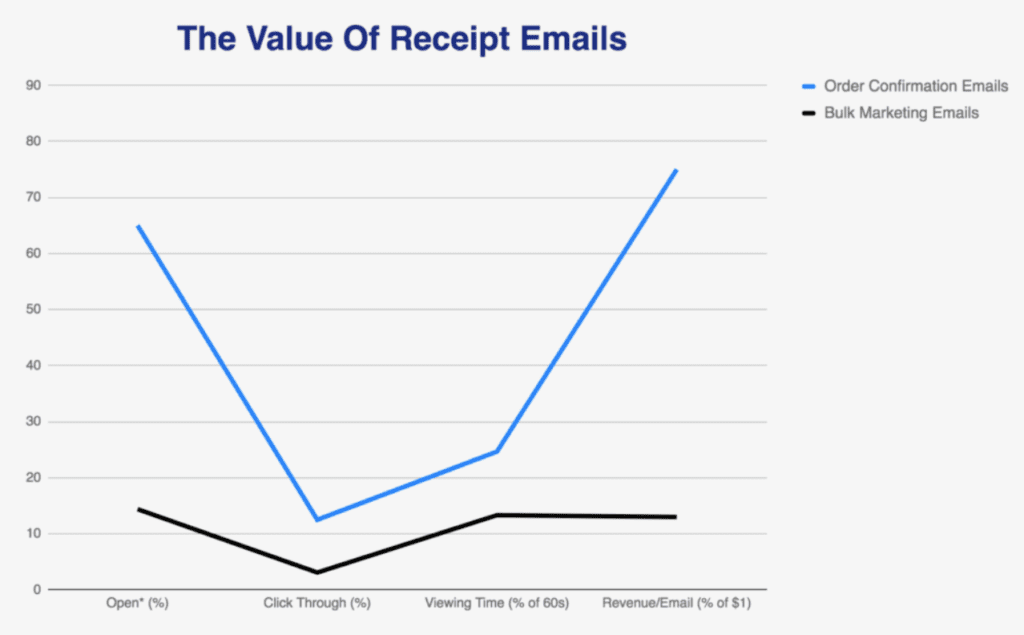
As you can see from the graph, a confirmation email has higher open rates, click-through rates, and viewing time. They also generate the highest revenue per email sent.
These are the type of confirmation messages that should include a promotion for your Shopify app:
- New subscriber confirmation
- Order confirmation
- Shipping confirmation
- Delivery confirmation
Each app promotion can have a slightly different angle, depending on the content of the message.
For example, “use the app for faster ordering” works well for an order confirmation message. But you could use something like “track shipping status directly in the app” for both shipping and delivery emails.
Here’s another reason why this mobile app ecommerce marketing idea is so useful; you’re targeting customers who are already interested in your brand. These are people who either signed up for email promotions or just purchased something from your Shopify store. This makes them the most likely candidates to download your ecommerce mobile app.
4. Offer an Incentive For Downloads
Why should someone download your new ecommerce app?
No, this is not a rhetorical question. You actually need to tell people why the app will benefit them personally.
According to our app download and usage statistics page, the average person has between 60 and 90 apps installed on their device. However, 77% of time is spent on just three apps. 75% of apps are used once and then never used again.
Consumers know this. They aren’t going to download another app to clutter their phones unless they are given a good reason.
Monetary incentives usually get the job done. You could offer something along the lines of 20% off the first purchase using the app. If you really want to make sure the app continues getting used, consider extending that discount for the first 30 days after installation.
Target has a dedicated landing page on its ecommerce site to promote the app.
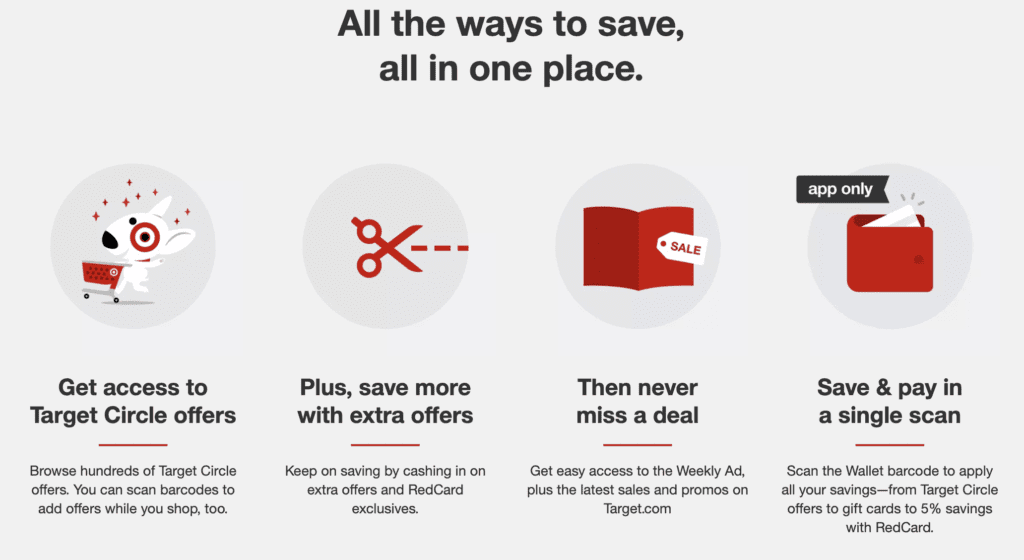
The page highlights some of the top features of the app, which gives users even more of an incentive to download it. Any feature, benefit, or advantage that adds value or makes the customer’s life easier needs to be mentioned when you’re marketing your Shopify mobile app.
5. Look For Guest Posting Opportunities
Does your Shopify site have a blog? If so, you’re already on the right track to increase the exposure for your brand and app.
But only publishing blogs on your website limits the exposure to an audience that already knows who you are. While you can still use your blog for mobile app ecommerce marketing, the readers likely know about it already.
Guest blogging allows you to increase the exposure of your app to an entirely new audience. You just need to find the right opportunities.
Use Google search strings as a resource for finding these opportunities.
- “Keyword” + “write for us”
- “Keyword” + “guest blog”
- “Keyword” + “guest post guidelines”
These are just a few examples of what you can search for. The benefits of guest blogging are tremendous and will help you drive Shopify sales with a mobile app.
Just make sure it’s not overly promotional. Most websites allow guest authors to include a handful of links to their website and other pages. So rather than promoting your app directly, simply include a download link embedded within the content.
6. Use Influencer Marketing to Your Advantage
Influencer marketing and guest blogging have similar benefits, in the sense that you’re getting exposed to a new audience. The difference between the two is that you’ll likely have to pay for an influencer to promote your app.
With that said, this mobile app ecommerce marketing strategy delivers strong results and high returns.
According to a recent study, 28% of online marketing managers named influencer marketing the fastest-growing customer acquisition strategy.
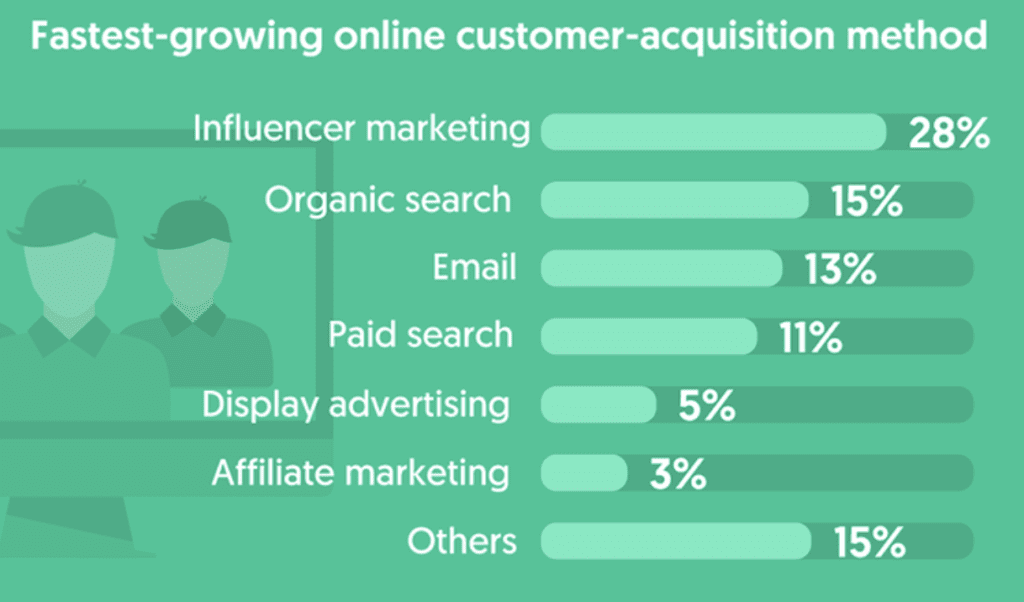
As you can see from the graph, this response ranked first on the list. Furthermore, 67% of brands say they plan to increase their influencer marketing budgets in the next 12 months.
The reason why influencer marketing is so effective is because consumers trust these people.
You don’t need to work with professional athletes, singers, or famous actors to have success with this strategy. Instead, you can partner micro-influencers with a strong reach within your niche. This is also much more cost-effective.
Check out these statistics about the rates for micro-influencers:
- Instagram post — 84% charge less than $250
- Facebook post — 90% charge less than $250
- Blog post — 87% charge less than $500
- Twitter post — 90% charge less than $150
These rates are very reasonable. In some instances, you could develop influencer relationships without having to pay for anything. Try offering free merchandise in exchange for a post about your ecommerce mobile app.
7. Use SEO Best Practices
We live in a world that’s completely driven by SEO. Every marketing campaign, including mobile app ecommerce marketing promotions, needs to be developed with SEO in mind.
Earlier I explained the importance of using your website as a promotional tool for your Shopify app. That strategy is useless if people aren’t actually visiting your site.
93% of all website experiences start with a search engine.
Take a moment to put yourself in the shoes of a current or prospective app user. If you want to do something online, where do you find it? Personally, I rarely go directly to a website. I almost always start with a Google search.
If you can apply SEO best practices to your app landing page and top-performing pages promoting your new ecommerce mobile app, it will drive traffic to those pages. As a result, this traffic increase will ultimately boost your Shopify app downloads as well.
8. Create an In-App Referral Program
One of my favorite ways to market an ecommerce app is by letting your existing app users do all of the work for you. All you need to do is set up a referral program and let the rest take care of itself.
The best in-app referral programs are simple and straightforward.
Using the “give $20, get $20” model is an excellent example of how to set this up. Allow app users to invite their friends to download the app in exchange for $20 per referral. The referred user gets $20 off of their first purchase, and the customer who referred them gets a $20 account credit once that transaction happens.
This mobile app ecommerce marketing strategy gives your current users an incentive to invite as many people as possible. If just five of their friends make a purchase, they can get $100 in credits.
Another reason why I love this strategy is because referred customers are the best types of customers to have.
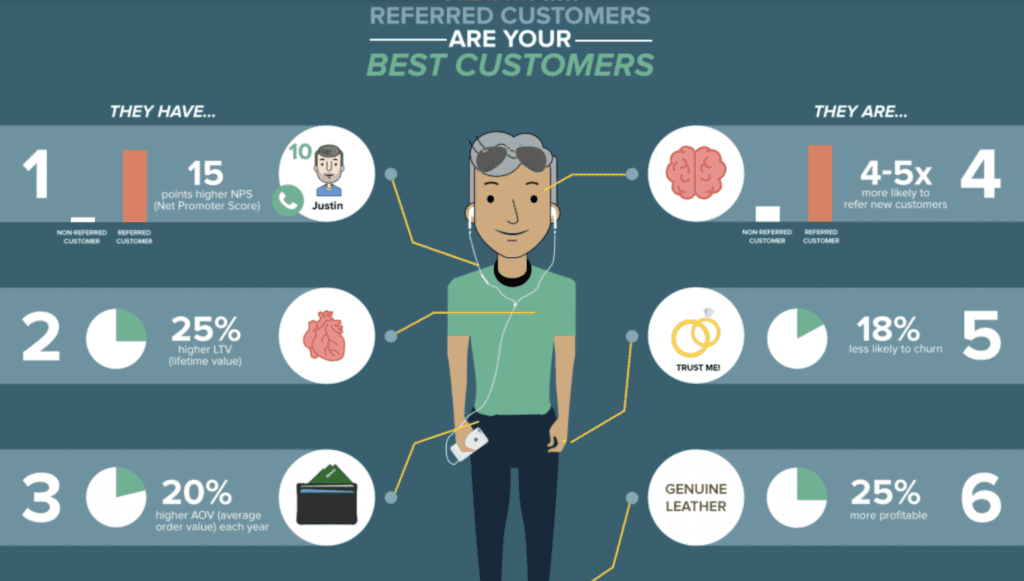
Furthermore, everyone trusts a referral. 92% of consumers say they trust a recommendation that comes from someone they know.
If my friend, sibling, coworker, or cousin sends me a referral to download an app, I’ll probably download it. Other people have the same mentality.
For those of you who are in a position where you’re comfortable giving away store credit for a download, it’s a great way to get downloads from people who will actually buy something from your new Shopify mobile app.
9. Improve Discovery with ASO (App Store Optimization)
In addition to SEO, you also need to prioritize ASO.
You want to make sure that your app is easily discoverable when a user searches for relevant keywords on the Apple App Store or the Google Play Store.
While app store optimization isn’t the most exciting mobile app ecommerce marketing strategy, it’s a necessity.
ASO best practices vary, depending on whether or not your app is available on iOS or Android. Let’s say you’ve previously built a Shopify app for Apple users, and now you’re thinking of developing one for Android. Don’t assume that those same ASO tactics will work on the Google Play Store.
I could write for days on how to implement proper ASO techniques for mobile app ecommerce marketing. But it will be easier (for both of us) if you check out these helpful guides instead:
- The Must-Have ASO Checklist for a Successful App Launch
- The Ultimate Guide to Effective App Store Optimization
- Increase Your App Downloads and Improve Mobile App Rankings
Remember, you can always subscribe to the BuildFire blog to be the first to know when we release helpful guides for your ecommerce mobile app.
10. Run a Contest or Giveaway Promotion
Contests, giveaways, and other promotions are a great way to get people excited about downloading your Shopify app. That’s why it’s one of my favorite app marketing ideas for ecommerce.
This relates back to one of our previous ideas about giving people an incentive to download the app. But a giveaway has additional benefits, which is why it deserves its own mention.
I’d recommend a “download, share, and win” promotion via social media. Instagram is the best place to run a contest since engagement rates are so high compared to regular posts.
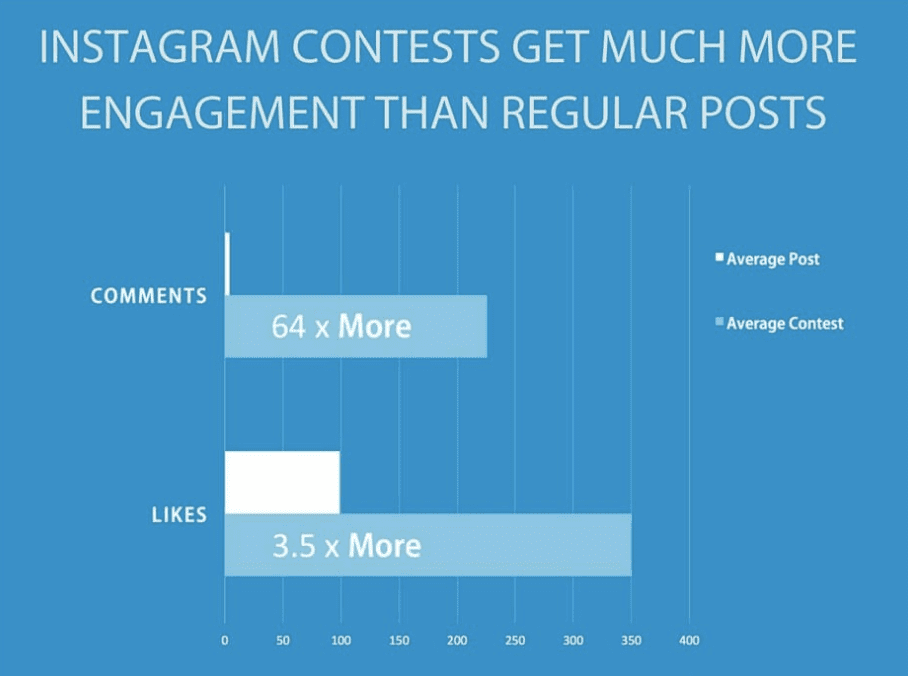
Here’s how it works.
To participate, users need to download your app, share it on their profile, and tag your company for a chance to win whatever you’re giving away. You can choose the parameters for the prize and how many winners you’re going to select.
Always include a deadline in these types of promotions. This creates a sense of urgency and gets people to start participating immediately.
In addition to the initial users who download the app to participate in the promotion, other people will also be exposed to your Shopify app as well. Anyone who follows users participating will see the post. It’s essentially free marketing for your ecommerce app.
I love this strategy because it combines the advantages of offering incentives, influencer marketing, and referrals into one campaign.
11. Leverage Free Distribution Platforms
This piggybacks off of my last point. It’s always going to be in your best interest to find as many free app marketing ideas as possible.
User acquisition doesn’t need to cost a fortune. Just enhance your presence on popular social media channels. Hopefully, you already have a profile set up on the following platforms:
- YouTube
Research your target audience to see what platforms they’re using the most. That’s what you should be prioritizing.
If your Shopify app sells products intended for younger generations, you can even consider setting up accounts on Snapchat and TikTok. I definitely missed the boat on those platforms (I’m getting old). But if my customers were on there, I’d make sure to use them as promotional channels for my Shopify app.
12. Facebook Ads
While free app marketing is obviously ideal, there’s nothing wrong with paying for ads if it’s in your budget. This is especially true for Shopify store owners who don’t have a strong presence on social media yet.
If you have a new ecommerce app and haven’t established your brand name, you’ll be pretty limited in terms of social media reach with a few hundred or a few thousand followers.
I prefer using Facebook ads because it gives you the opportunity to target certain people. It’s the best way to reach your audience.
Facebook even has specific ad campaign objectives for driving app installs.

The steps are simple:
- Pick an objective
- Choose your audience
- Decide where your ad is run (can be on Instagram too)
- Choose a format
- Set your budget
You’ll get detailed reports to measure the results of your ads as well. This is the perfect way to know if your campaigns are actually driving app downloads.
13. Geofencing PPC with Google Ads
For those of you who have physical brick-and-mortar store locations, in addition to your Shopify site and ecommerce app, geofencing with Google PPC is definitely something you should consider.
This Google Ads tool allows you to target customers in a specific area. This can be based on neighborhoods, zip codes, or areas near your store.
So if a customer walks by your shop or into one of your stores, it will trigger an ad for them when they visit a website in the Google advertising network.
You can take advantage of this app marketing idea, even if you don’t have a physical store presence.
For example, let’s say your Shopify mobile app sells bathing suits, shorts, sandals, and other warm-weather apparel. It wouldn’t make sense to run ads targeting people in New York City or Chicago during the winter. But southern California, Miami, and Hawaii are perfect locations to target year-round.
14. Create a Customer Loyalty Program
Loyalty programs encourage your existing customers to spend more money.
By integrating a loyalty program into your Shopify app, it becomes an indirect promotion of the app and its benefits. Here’s why.
For a customer to receive rewards, they must be logged into their customer profile. But this is a hassle when shopping from a computer or mobile device. The customer will either check out as a guest or just ignore the loyalty benefits.
The app will make it easier for users to track and receive the benefits associated with the program. They’ll know exactly how many rewards they’ve earned for the month, year, or given time frame.
15. Encourage and Promote App Reviews
App reviews and ratings can impact ASO, which is something that we previously talked about. But beyond app store optimization, you can highlight the top app reviews on your website and social media platforms.
Think of it the same way as a product review or testimonial on your Shopify site. Those reviews motivate people to buy. Well, an app review will persuade people to download.
The only way that this works is if you’re getting app reviews in the first place. Most people won’t go out of their way to write a review unless they had a really good or really poor experience. But 90% of users will fall somewhere in the middle.
So it’s up to you to find ways to encourage Shopify app reviews. Incentives and popups are usually enough to get the job done.
Conclusion
Mobile marketing for ecommerce is crucial to the success of your app.
Coming up with creative marketing ideas for a Shopify app is the best way to get your name out there and drive downloads. Otherwise, nobody will know that your app even exists.
I realize that implementing 15 tactics for your new ecommerce mobile app might be a bit overwhelming. But you don’t need to use all of these at once. You can pick and choose which strategies to start with based on the status of your app.
A Shopify app that’s still in development will need a different marketing approach than an ecommerce app that launched two years ago.
Regardless of your situation, make sure you subscribe to the BuildFire blog. We’ll provide all of the tips, tricks, and ecommerce app tools you need to make sure your Shopify app is successful.